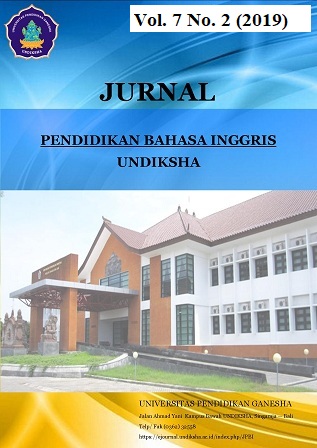THE STUDY OF TPR IMPLEMENTATION IN TEACHING LISTENING AND SPEAKING FOR ELEMENTARY SCHOOL AT SD LABORATORIUM UNDIKSHA SINGARAJA IN THE ACADEMIC YEAR 2013/2014
DOI:
https://doi.org/10.23887/jpbi.v7i2.20388Abstract
Abstract
This study was a descriptive qualitative research, which aimed to find out the implementation of TPR method for teaching listening and speaking, the reasons why the teacher chose TPR method and what the problems were faced by the teacher in implementing TPR method for teaching listening and speaking. The subjects of the study were the English teacher and the 32 students Class 5A, SD Laboratorium Undiksha Singaraja. This study was in the form of case study. The data were collected by using four instruments, interview guide, observational checklist, recorders and test in order to prove the teacher’s statement about students’ improvement. The data obtained were then analyzed descriptively. There were three main processes of data analysis: data reduction, data display and drawing conclusion/ verification. From the overall findings, it can be concluded that TPR method was implemented in accordance to the theory conceptualized by Larsen-Freeman (2000) and Richards & Rodgers (2001) and was combined with songs. Based on the teacher’s statement and test result, the reasons why TPR method was used because it made students enjoy the class, easy to understand the material and teacher considered TPR method was effective to improve students’ ability in listening and speaking. However, there were few problems faced by the teacher in implementing TPR for teaching listening and speaking, namely: The students’ characteristic affects their confidence in TPR activities, and TPR was not flexible to be implemented for all materials and students’ levels.
Keywords: TPR Method, Listening, Speaking
References
Brown, H. D. 2000. Teaching by principles: an Interactive approach language pedagogy. Pearson Longman
Hendrawan, R. 2012. Teaching Speaking English Using Total Physical Response Method. Bandung: Unpublished Thesis.
Ilwana, N. 2010. The Effectiveness of Total Physical Response (TPR) to Enhance Students’ Vocabulary Mastery (An Experimental Study at the Seventh Grade of SMP N 3 Ajibarang) In Academic Year 2009/2010. Surakarta: Unpublished Thesis .
Larsen-Freeman, D. 2000. Technique and Principles in Language Teaching (2nd ed.). New York: Oxford University Press
MGMP. 2006. Kurikulum Tingkat Satuaan Pendidikan SD Laboratorium Undiksha Singaraja. Singaraja : SD Laboratorium Undiksha Singaraja.
Mohhamed, R. 2009. Total Physical Response. Retrieved from http://myenglishpages.com/blog/total-physical-response on 12 February 2013
Nurkhasanah, I. 2011. The Use of Brainstorming in Increasing Student’s Motivation in Speaking Ability Al-Muhibbin Junior High School Grade VIII. Retrived from http://iinnurkhasanah.wordpress.com/2011/07/25/thesis-proposal on 18 March 2013
Octaviany, Y. 2007. The Application of Total Physical Response in Teaching English Vocabulary To The Fourth Graders of SD Negeri 04 Krajankulon Kaliwungu Kendal in the academic year of 2006/2007. Semarang: Semarang State University
Prastowo, B.S. 2012. Teaching speaking Using Total Physical Method and Fun games for Fourth Grade in SD Pangudi Luhur Surakarta. Surakarta: Unpublished Thesis.
Scott, T. 2005. How to Teach Speaking. New York: Pearson Longman
Richards, J.C & Rodgers, T.S. 2001. Approaches and Methods in Language Teaching. UK: Cambridge University Press
Richards, J.C. 2008. Teaching Listening and Speaking. New York: Cambridge University Press
Widodo, H. P. 2005. Teaching Children Using a Total Physical Response (TPR) Method. Jember: Unpublished thesis.
Downloads
Published
Issue
Section
License
Authors who publish with the Jurnal Pendidikan Bahasa Inggris Undiksha agree to the following terms:- Authors retain copyright and grant the journal the right of first publication with the work simultaneously licensed under a Creative Commons Attribution License (CC BY-SA 4.0) that allows others to share the work with an acknowledgment of the work's authorship and initial publication in this journal
- Authors are able to enter into separate, additional contractual arrangements for the non-exclusive distribution of the journal's published version of the work (e.g., post it to an institutional repository or publish it in a book), with an acknowledgment of its initial publication in this journal.
- Authors are permitted and encouraged to post their work online (e.g., in institutional repositories or on their website) prior to and during the submission process, as it can lead to productive exchanges, as well as earlier and greater citation of published work. (See The Effect of Open Access)













